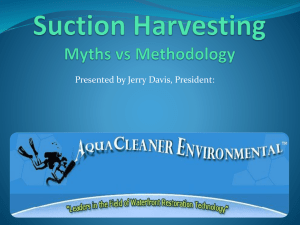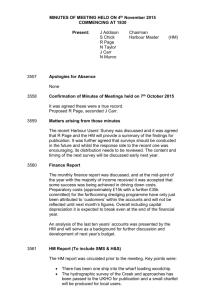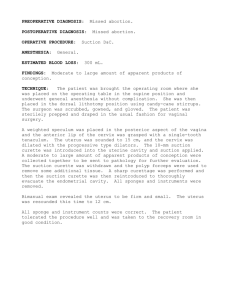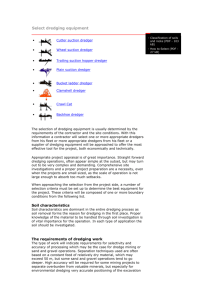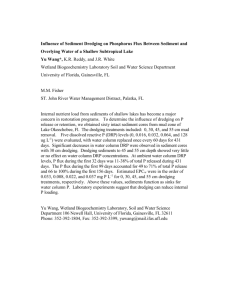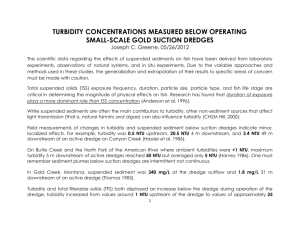Fish feeding below the outfall from a small
advertisement
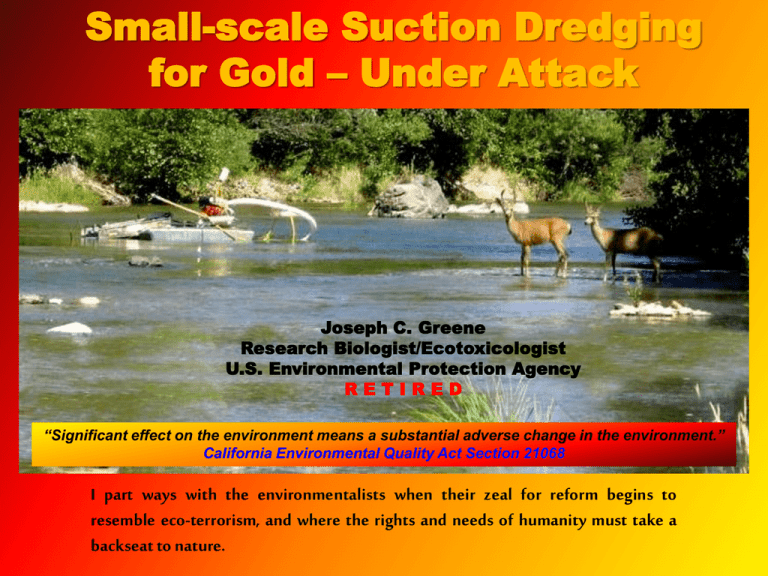
Small-scale Suction Dredging for Gold – Under Attack Joseph C. Greene Research Biologist/Ecotoxicologist U.S. Environmental Protection Agency RETIRED “Significant effect on the environment means a substantial adverse change in the environment.” California Environmental Quality Act Section 21068 I part ways with the environmentalists when their zeal for reform begins to resemble eco-terrorism, and where the rights and needs of humanity must take a backseat to nature. THIS PRESENTATION IS An HONEST review of scientific research results regarding the effects of small-scale gold suction Dredging. THESE DATA demonstrate that the process OF SMALL-SCALE GOLD SUCTION dredging is NOT harmful to man, fish, or the environment. Motor and Air Pump ------- --- Head Box Water --- Pump Pump output hose > - Sluicebox (gravity filter) Flotation Eductor ------------- < Intake and foot valve Suction Hose --- - miner Salmon Eggs Alevin Harvey and Lisle, 1998, Effects of Suction Dredging on Streams, A Review and Evaluation Strategy Fishery managers should be especially concerned when dredging coincides with the incubation of embryos in stream gravels – Harvey & Lisle Suction dredge equipment, used by modern-day gold miners on the Klamath and other California rivers, dirty the rivers and disturb the spawning grounds of already imperiled fish. Photo: courtesy Craig Tucker, Karuk Tribe the Northcoast Environmental Center, http://yournec.org/index.php?module=pagesetter&func=viewpub&tid=3&pid=741 Flood Stage, Klamath River above Portuguese Creek, 2006 “Mining debris is chemically inert, makes no oxygen demand on the stream and therefore takes away from the flowing water nothing which the fish require. This is equally true of this material whether placed in transit by nature or by man since the products are alike in nature and comes from the same sources…” Turbidity was 656 NTU Swartley, A. M. Appendix A. In: Ward, H. B. 1938. Placer Mining on the Rogue River, Oregon, in Its Relation to the Fish and Fishing in 7 that Stream. Department of Geology and Mineral Industries, State of Oregon, Portland, OR Klamath River water: The vials were allowed to settled for 24-hours, the right vial was shaken to re-suspend the particulates. The sample was measured at 656 NTU. 8 Samples provided by Jim Foley and prepared by Claudia Wise Research has found that duration of exposure plays a more dominant role than TSS concentration (Anderson et al. 1996). For example, turbidity was 0.5 NTU upstream, 20.5 NTU 4 m downstream, and 3.4 NTU 49 m downstream of an active dredge on Canyon Creek (Hassler et al. 1986). On Butte Creek and the North Fork of the American River where ambient turbidities were <1 NTU, maximum turbidity 5 m downstream of active dredges reached 50 NTU but averaged only 5 NTU (Harvey 1986). One must remember sediment plumes below suction dredges are intermittent not continuous. Wanty et al. (1997) reported turbidity values of 19 NTU 30.5 m (100 ft) downstream of a 10 inch dredge located below Wilson Creek on the North Fork Fortymile River. Values returned to near background levels (3.7 NTU) within the next 30.5 m but remained slightly above background levels (2.2 - 2.3 NTU) as far as 150 m downstream In Gold Creek, Montana, suspended sediment was 340 mg/L at the dredge outflow and 1.8 mg/L 31 m downstream of an active dredge (Thomas 1985). THE ROGUE RIVER AS IT FLOWS PAST THE GRANTS PASS, OREGON, SEWAGE TREATMENT PLANT, MAY 10, 2005. ACCORDING TO THE GRANTS PASS DAILY COURIER, TURBIDITY IN THE RIVER DUE TO RECENT RAINS MEASURED AT APPROXIMATELY 54-61 NTUs. Sewage Treatment plants require “NPDES” permits . . . According to EPA and DEQ, So do suction dredges. Approximate size of a 4-inch Suction Dredge By Tom Kitchar The addition of a pollutant into a water system is key to whether or not the EPA and the OR DEQ have regulatory jurisdiction over specific mining activity. Suction dredging within the normal high water mark of a river channel does not add a pollutant to the water system. Because the miners and prospectors are in the river channel, they can’t add anything that isn’t already there. U. S. Supreme Court Justice Sandra Day O’Connor’s majority opinion rendered in the South Florida Water Management District v. Miccosukee Tribe of Indians et al. tends to support the miner’s position that turbidity is not a pollutant added to a waterway. The Chief Justice likened a water system to a pot of soup. She reasoned that, “If one takes a ladle of soup from a pot, lifts it above the pot, and pours the soup back into the pot, one has not ‘added’ anything else to the pot.” Impact WQ‐2: Effects of Contaminant Discharges of Oil or Gasoline Used in Suction Dredges (Less than Significant) …the amount of fuel and oil spilled each year into surface water caused by recreational dredging activities would be anticipated to be relatively small based on the size of dredging motors, total number of dredges anticipated to operate under the Program, and low probability that any individual dredger would cause substantial fuel or oil spills while refueling. California Department of Fish and Game, Suction Dredge Permitting Program, Draft Subsequent Environmental Impact Report, February 2011, page 4.2-28 Leroy Cyr, Fish Biologist, 2005, Interoffice Memorandum to Jerry Boberg, Fish and Watershed Program Manager, Six Rivers National Forest. Leroy Cyr, Fish Biologist, 2005, Interoffice Memorandum to Jerry Boberg, Fish and Watershed Program Manager, Six Rivers National Forest. 2004 SALMON RIVER, CA STUDY 53 dredging sites were documented within the Salmon River Basin. 1,066 linear feet of river bottom was dredged within the entire river system. The North Fork, South Fork and mainstem Salmon River is approximately 79 miles long (417,120 linear feet). Suction dredge holes disturbed <0.26% of the river bottom. Leroy Cyr, Fish Biologist, 2005, Interoffice Memorandum to Jerry Boberg, Fish and Watershed Program Manager, Six Rivers National Forest. Salmon River Study Conclusions by Greene Refugia are defined in the literature as any hole in a river bottom that is 3 feet in depth or deeper. This study identified 27 such holes caused by suction dredging. Therefore, suction dredge holes disturbed only <0.26% of the river bottom, and 51% of the 53 dredged holes had the potential for improving the habitat to support the survival of species in the river. Dredge hole in the Klamath with circling salmon, September 2009, Avery Rathburn Sample Letter to Legislators In his court declaration Dr. Peter Moyle stated, “It should be assumed there is harm, unless it can be proven otherwise, One reason for my taking this conservative position is that we simply do not know the effects of dredging on many species” (page 8, lines 13-15). He goes on to say, “Even for salmonids, information on the effects of dredging, with the exception of a few studies such as that of Harvey (1998), is largely anecdotal or in nonpeer reviewed reports” (page 8, lines 20-23). Declaration of Peter B. Moyle, Ph.d., In Support of Entry of Stipulated Agreement, Karuk vs CA Dept. Fish and Game, Superior Court of California, County of Alameda, Hayward Division, Case No: RG 05 211597. Jan. 06, 2006. 22 Effects of dredging commonly appear to be minor and local, but natural resource professionals should expect effects to vary widely among stream systems and reaches within systems. … Given the current level of uncertainty about the effects of dredging, where threatened or endangered aquatic species inhabit dredged areas, fisheries managers would be prudent to suspect that dredging is harmful to aquatic resources. HARVEY AND LISLE, 1998, Effects of Suction Dredging on Streams, A Review and Evaluation Strategy Bret C. Harvey is a fish ecologist and Thomas E. Lisle is a geomorphologist for the U.S. Forest Service, Pacific Southwest Research Station, 1700 Bayview Drive, Arcata, CA 95521 USA In 1,388 pages of text IN THE CALIFORNIA SUBSEQUENT ENVIRONMENTAL IMPACT REPORT (SEIR) the term “Is Proven” is not once used. There are over forty years of suction dredging history yet the SEIR must speculate on what “may” occur if gold dredging resumes. % 74.0 1.8 21.9 1.3 0.4 0.6 This chart illustrates that 99-percent of the supporting statements were based upon conditional verbs not scientific results. Western Mining Alliance 2012 99% Fish feeding below the outfall from a small-scale gold suction dredge sluice box 25 More fish feeding behind small-scale gold suction dredges Effect of scale 27 28 CONCLUSION Small-scale gold suction dredging effects a very small area in the environment relative to the entire area in which all dredges operate. But, what about government activity and their effect on the environment??? Grand Canyon awash with Sediment as Scientists Study Impact The White Salmon River, WA at its confluence with the Columbia has filled with silt and is only inches deep since the breaching of Condit Dam. The first 300 yards upstream from the Highway 14 bridge, once 18 to 20 feet deep and a popular trolling spot for boating anglers, now has just a few inches of water running over a deep bed of sediment. The sluice box filters out gold, platinum, lead, mercury, and many scrap metals from the river’s gravels. We recovered 65 lbs of lead, from the Lewis River, WA in just one fishing hole so far and we have not finished with it. Yet. Note from Scott Atkinson Garbage in the river? Say it ain’t so!! Source: Western Mining Alliance Source: Western Mining Alliance Realize that all this stuff was taken out of ONE dredge hole during a summer season on the South Fork of the American River. Source: Western Mining Alliance IS IT ENVIRONMENTAL CONCERN THAT'S DRIVING MINING OUT OF THE UNITED STATES OR RATHER POLITICS ON THE GRANDEST SCALE? The current administration has designated millions of acres of federal land off-limits to multiple uses such as mining---and seems to be attempting to lock up public land --- all without consulting Congress or the public. The administration seems to be conforming U.S. environmental policy to United Nations Strategies. The International Union for Conservation of Nature, an accredited scientific advisory body to the United Nations, incorporates U.S. federal agencies, non-governmental organizations and United Nations agencies in its proclaimed war against "ignorant humans." Globalizing Mining in America, from Mining Voice Magazine Volume 6(2):26-35, March-April 2000 Critics of the administration’s land grab point to the United Nations. They accuse the president of implementing the UN’s Agenda 21 and the Convention on Biological Diversity. Both were introduced during the June 1992 Earth Summit held in Rio de Janeiro, Brazil. Agenda 21 is a 40-chapter, 381 page book focused on reorganizing society around "sustainable" use and development of the planet. Based on socialist principles of equal sharing of all natural resources. Agenda 21 sets a goal to control all human activity to protect the Earth’s ecosystems and biological diversity. Mining, for instance, would have to be "environmentally sound" and could only be done "in areas adjacent to protected areas with a view to furthering protection of these areas." The meaning of "protected areas" and "environmentally sound" is not defined in Agenda 21, but it is clarified in the UN Convention on Biological Diversity (Biodiversity Treaty) and the Wildlands Project. Dr. Reed Noss who is associated with the Wildlands Project as well as the University of Oregon and other radical environmental groups describes a corridor that would be needed to assure viability of the grizzly bear in Montana. "If the population of grizzlies in the Greater Yellowstone Ecosystem is to be connected to other populations, which seems to be necessary to assure population viability, then wide corridors with resident grizzlies must connect Yellowstone with the Northern Continental Divide Ecosystem (about 200 miles away) and the wildlands of central Idaho. …corridor for grizzly bears should be at least 27.5 miles wide." In further describing the corridor, he states, "Because Road densities above about 0.5 miles of road per square mile of habitat may be a threat to grizzlies, road closures would be required to make inter-regional corridors safe ." TECHNICAL REVIEW OF THE WILDLANDS PROJECT AND HOW IT IS AFFECTING THE MANAGEMENT OF STATE, FEDERAL AND PRIVATE LANDS IN THE UNITED STATES by Tom McDonnell This review details much of the structure and objectives of the Wildlands Project. During the past several years, resource industries, state and local governments and communities nationwide have been buried under an avalanche of: new species listings; appeals and litigation to stop water development, logging, mining, grazing and recreational activities. There have been vast amounts of legislation proposing new wilderness areas, heritage areas, scenic rivers, biological corridors, state and national parks or wildlife refuges, as well as management plans involving critical habitat, watersheds or ecosystems. http://citizenreviewonline.org/april_2002/wildlands_project_history.htm While many of these actions seem to be isolated incidence, a review of Wildlands Project documents suggests that the actions are often well coordinated activities aimed according to the Project's text at establishing a "regional reserve system which will ultimately tie the North American continent into a single Biodiversity Reserve." http://citizenreviewonline.org/april_2002/wildlands_project_history.htm …the mission articulated by White House Science and Technology czar, John Holdren, who said, “A massive campaign must be launched to restore a high-quality environment in North America and to de-develop the United States.” Paul and Anne Ehrlich and John Holdren, Human Ecology Problems and Solutions (San Francisco: WH Freeman and Company, 1973), 279. Significant additions to the timetable, was provided by President Barack Obama. Consider the executive memorandum quietly issued by the White House on April 16, 2010, deceptively titled “America’s Great Outdoors Initiative.” The stated goals of the Initiative: Reconnect… America’s rivers, waterways, landscapes of national significance, ranches, farms and forests, great parks, and coasts and beaches by… creating corridors and connectivity across these outdoor spaces, and for enhancing neighborhood parks; and determine how the federal government can best advance those priorities though public/ private partnerships and locally supported conservation strategies. Barack Obama, “Presidential Memorandum— America’s Great Outdoors,” White House, April 16, 2010. In presenting his unilateral order, Obama sealed the deal on what promoters of the green agenda have desired for decades: “reconnect” the land of North America, creating several sweeping “corridors” designed to provide seamless “connectivity” between millions of acres of “outdoor spaces.” Notice that “ranches, farms and forests” and “coasts and beaches” are also included in the reconnection goals. This means that private ownership of such property is in the crosshairs of this scheme. The Initiative will be advanced by “the federal government… working through public/ private partnerships and locally supported conservation strategies.” This simple phrase empowers environmental organizations and their deeppocketed donors to have a seat at the table with policymakers at all levels of government. Barack Obama, “Presidential Memorandum— America’s Great Outdoors,” White House, April 16, 2010. Sign Petition: This is why it is important! Each year since 1986, American Rivers has released its America's Most Endangered Rivers report to spotlight the nation's ten most imperiled rivers. This year, the Chetco River found itself at #7 on the Most Endangered Rivers List. Southern Oregon's Wild and Scenic Chetco River boasts pristine waters and abundant wild salmon and steelhead, but it faces an immediate threat from a strip mining proposal damaging method of dredging. that would use a highly Oregon's Senators Wyden and Merkley, Congressman DeFazio, and Governor Kulongoski are calling on the agencies that manage this river to prohibit mining in or near the Chetco River this summer. This reprieve would allow Congress time to legislate the best possible long-term protection for the Chetco River. http://www.change.org/petitions/the-endangered-chetco-river-needs-your-help The Chetco River, Oregon “faces an immediate threat from a strip mining proposal that would use a highly damaging method of dredging.” Why have a consortium of extreme environmental groups joined together together to deny small-scale gold suction dredgers their right to mine? Karuk Tribe Pacific Coast Federation of Fishermen’s Associations Institute for Fisheries Resources Klamath Riverkeeper Center For Biological Diversity Friends of the River California Tribal Business Alliance The Sierra Fund California Trout Environmental Law Foundation Environmental Justice Coalition for Water Friends of the North Fork American California Sportfishing Protection Alliance The decision to change our name to “Wildlands Network” has been both exciting and difficult. “Wildlands Project” has been a cherished part of our 18-year history. However, thanks to you and our other partners and supporters, we are no longer just a project. We are an expanding network of conservationists. You are part of this network that is continuing to tackle the continental challenge of protecting healthy North American wildlands and wildlife far into the future. http://www.twp.org/sites/default/files/wc_fall08.pdf Social engineering and behavior modification are some of the true objectives being implemented under the guise of environmental and climate protection. This is accomplished by exploiting people's desire to maintain a healthy and lasting environment in the name of “sustainability.” the concept of sustainability is a call for government policies that demand changes in human behavior and lifestyles under penalty of law. On its own, SUSTAINABILITY is one of those slogans that sounds typically benign: But like most left-oriented expressions, there is a sinister translation. United nations Agenda 21 calls for worldwide population reduction and suggests moving people from rural areas to the cities, so “sustainable development” can be more easily managed. One of the United nations objectives is to reduce the world’s human population by up to two-thirds of what is was in 1992. Eco-Tyranny “While I was researching Climategate, I was astonished by a recurring theme: since the inception of the environmental movement, its leaders have been consumed with eliminating capitalism and ushering in a global era of socialism. Their call for being “green” goes far beyond demanding clean air, pure water, healthy forests, and alternative sources of energy. The leftists at the helm of the environmentalist hierarchy want to control the air, water, forests, and natural resources.” Brian Sussman, (2012). Eco-Tyranny: How the Left's Green Agenda will Dismantle America. “These leftists contend that some people are randomly spit out of their mother’s womb with a better brain than most. Those with the best brains have a Darwinian authority to rule over those with the lesser brains, lest those with the deficient brains destroy the planet and kill one another; thus, the need for a heavy-handed form of government loaded with burdensome regulations, and the perfect excuse for socialism, communism, and fascism.” Brian Sussman, (2012). Eco-Tyranny: How the Left's Green Agenda will Dismantle America. “Leftists (Marxists) believe they have the power to define all societal morality, rules, and laws subject to their goals. Hence, the inalienable rights of life, liberty, and the pursuit of happiness as recognized by America’s founders are viewed as absurd, because an imaginary God cannot declare rights. Marxism demands that all so-called rights be issued by the government in the form of laws. And just as a law can be issued by the government, so shall it be taken away by that government if deemed necessary.” Brian Sussman, (2012). Eco-Tyranny: How the Left's Green Agenda will Dismantle America. The environmental agenda has been infected by extremism—it's become an economic suicide pact. You must understand, the green agenda— from guano to global warming— is not about celebrating the beauty of our planet; it is an assault on mankind. It’s an agenda that has no regard for your needs, lifestyle, dreams, desires, or feelings. Brian Sussman, (2012). Eco-Tyranny: How the Left's Green Agenda will Dismantle America. ENVIRONMENTALIST ACTIVISTS (eco-socialists) ARE DOGMATIC, ideological radicals hell-bent on transforming society into a colossal, highly regulated, redistributive commune void of inalienable rights. Their lack of integrity enables them to look you straight in the eye and lie about the facts, while they spin out tailor-made, cherrypicked research supposedly proving their many fictitious claims regarding the state of the global ecosystem. The primary goal of their green agenda is not a pristine environment— it’s about gaining absolute control over your life. Brian Sussman, (2012). Eco-Tyranny: How the Left's Green Agenda will Dismantle America In June 1972, official representatives from 113 countries, hundreds of nongovernmental organizations, and thousands of media outlets assembled in Sweden to change the world. The Declaration was nothing less than socialism cleverly cloaked in an ecological wrapper— “ reduce the gap” between the rich and poor; “shape our actions” by surrendering to nature; “demand the acceptance of responsibility” through heavy-handed government regulations and laws. It was a corrupted prescription written with the goal to one day infect America. Brian Sussman, (2012). Eco-Tyranny: How the Left's Green Agenda will Dismantle America UNITED NATIONS Agenda 21 is a carefully disguised attempt to hijack the worthy cause of environmentalism in the pursuit of political objectives. ECO-TYRANNY How the Left’s Green Agenda Will Dismantle America Midpoint Trade Books 27 West 20th Street, Suite 1102 New York, NY 10011 First Edition ISBN: 978-1-936488-50-6

